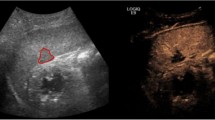Abstract
Study Objective:
Our aim was to determine the diagnostic significance of the association between the abdominal skin bruise from a seat belt and the presence of intraabdominal injury.
Methods:
This was an observational analysis of prospectively collected data on 45 patients who presented with an abdominal seat belt sign to a level 1 trauma center following a motor vehicle accident between July 2004 and December 2007. The patients were evaluated by computed tomography (CT) scans or ultrasonography (FAST), depending on their hemodynamic stability. They were then hospitalized for treatment or observation.
Results:
Forty-five patients [23 males (51.1%) and 22 females (48.9%)], with a mean age of 32.2 years (range 16–80 years), fulfilled entry criteria and were enrolled. Of these, 44 (97.8%) underwent CT, and one (2.2%) underwent FAST due to hemodynamic instability. two patients (4.4%) had intraabdominal injuries: one required surgery for bowel injury, and the other had a minor liver laceration, which was managed expectantly. Sixteen patients (35.5%) had concomitant injuries. The length of hospital stay ranged from 1–23 days (median 2.2 days).
Conclusions:
Despite the widely accepted view that patients with an abdominal seat belt sign are more likely to have serious intraabdominal injuries, the results of our investigation showed no such association in a group of hemodynamically stable patients.
Similar content being viewed by others
References
Rutledge R, Lalor A, Oller D, Hansen A, Thomason M, Meredith W, Foil MB, Baker C. The cost of not wearing seat belts. A comparison of outcome in 3396 patients. Ann Surg 1993;217:122–7.
Garrett JW, Braunstein PW. The seat belt syndrome. J Trauma 1962;2:220–38.
Doersch KB, Dozier WE. The seat belt syndrome. The seat belt sign, intestinal and mesenteric injuries. Am J Surg 1968;116:831–3.
Hayes CW, Conway WF, Walsh JW, Coppage L, Gervin AS. Seat belt injuries: radiologic findings and clinical correlation. Radiographics 1991;11:23–36.
Asbun HJ, Irani H, Roe EJ, Bloch JH. Intra-abdominal seatbelt injury. J Trauma 1990;30:189–93.
DiPerna CA, Rowe VL, Terramani TT, Salim A, Hood DB, Velmahos GC, Weaver FA. Clinical importance of the “seat belt sign” in blunt trauma to the neck. Am Surg 2002;68:441–5.
Rozycki GS, Tremblay L, Feliciano DV, Tchorz K, Hattaway A, Fountain J, Pettitt BJ. A prospective study for the detection of vascular injury in adult and pediatric patients with cervicothoracic seat belt signs. J Trauma 2002;52:618–623 discussion 623-4.
Muñiz AE, Haynes JH. Delayed abdominal aortic rupture in a child with a seat-belt sign and review of the literature. J Trauma 2004;56:194–7.
Freeman CP. The seat-belt sign. Arch Emerg Med 1987;4:128–130.
Nakamoto SK, Taylor A Jr. The seat belt sign. Clin Nucl Med 1981;6:586.
Eray O, Oktay C, Cete Y, Bozan H, Colak T, Akyol C, Ersoy FF. Is seat belt sign a predictor for physicians in management of trauma patients in emergency settings? Ulus Travma Derg 2001;7:139–41.
Anderson PA, Rivara FP, Maier RV, Drake C. The epidemiology of seatbelt-associated injuries. J Trauma 1991;31:60–7.
Chandler CF, Lane JS, Waxman KS. Seatbelt sign following blunt trauma is associated with increased incidence of abdominal injury. Am Surg 1997;63:885–8.
Wotherspoon S, Chu K, Brown AF. Abdominal injury and the seat-belt sign. Emerg Med (Fremantle) 2001;13:61–5.
Rutledge R, Thomason M, Oller D, Meredith W, Moylan J, Clancy T, Cunningham P, Baker C. The spectrum of abdominal injuries associated with the use of seat belts. J Trauma 1991;31:820–6.
Porter RS, Zhao N. Patterns of injury in belted and unbelted individuals presenting to a trauma center after motor vehicle crash: seat belt syndrome revisited. Ann Emerg Med 1998;32:418–24.
Velmahos GC, Tatevossian R, Demetriades D. The “seat belt mark” sign: a call for increased vigilance among physicians treating victims of motor vehicle accidents. Am Surg 1999;65:181–5.
Sokolove PE, Kuppermann H, Holmes JF. Association between the “seat belt sign” and intra-abdominal injury in children with blunt torso trauma. Acad Emerg Med 2005;12:808–13.
Greingor JL, Lazarus S. Chest and abdominal injuries caused by seat belt wearing. South Med J 2006;99:534–5.
Author information
Authors and Affiliations
Corresponding author
Rights and permissions
About this article
Cite this article
Makrin, V., Wiesel, O., Heller, D. et al. Low probability of Significant Intra-Abdominal Injury in Stable Patients with Abdominal ‘‘Seat Belt Sign’’. Eur J Trauma Emerg Surg 35, 403–406 (2009). https://doi.org/10.1007/s00068-008-8161-2
Received:
Accepted:
Published:
Issue Date:
DOI: https://doi.org/10.1007/s00068-008-8161-2




